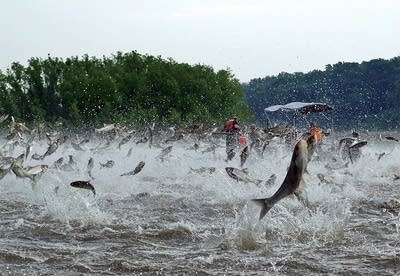US Army Corps to study Asian carp, other invasives
Go Deeper.
Create an account or log in to save stories.
Like this?
Thanks for liking this story! We have added it to a list of your favorite stories.

By Tammy Webber, Associated Press
Chicago (AP) - The U.S. Army Corps of Engineers released a plan Tuesday to study how to prevent invasive species - including the voracious Asian carp - from migrating between the Great Lakes and Mississippi River watersheds, calling it a "massive and complex" effort that could take years.
The primary focus of the estimated $25 million study will be on Chicago-area waterways, where canals provide the only direct connection between the two basins. But the Corps also will look at other areas where flooding could allow invasive species to slip from one watershed to the other.
Concern that the Asian carp, which can grow to 4 feet and 100 pounds, were close to Lake Michigan prompted the study. But Maj. Gen. John Peabody, commander of the Corps' Great Lakes and Ohio River Division, said it will look at many different types of invasive species.
Turn Up Your Support
MPR News helps you turn down the noise and build shared understanding. Turn up your support for this public resource and keep trusted journalism accessible to all.
A final recommendation on how to stop the movement of such species - possibly by separating the watersheds permanently - is expected to be made in 2015, Peabody said.
"The scope of this study is massive and complex," covering an area over 1,000 miles long with dozens of invasive species and "no known or single set of solutions," Peabody said. "It will take time, support and cooperation."

Joel Brammeier, president of the Alliance for the Great Lakes, expressed frustration that the Corps wasn't further along in its study, which was authorized by Congress in 2007 and funded last year.
"Is this where we stand ... a plan to do a project?" Brammeier said. "We all know a solution will not come online overnight, but we continue to see deadlines pushed back."
The Alliance advocates permanently separating the two watersheds to stop the carp from getting into Lake Michigan. Right now, a series of electronic barriers in the shipping canals that deliver a jolt to the fish are the only thing between them and the lake.
Asian carp have been migrating up the Mississippi and Illinois rivers toward the Great Lakes for decades. Biologists fear if the ravenous fish get into the lakes, they could decimate a $7 billion-a-year fishing industry by outcompeting native fish for food.
But the shipping industry has argued that any solution must allow them to still be able to move goods between the Great Lakes and inland waterways.
"Is this where we stand ... a plan to do a project?"
Peabody said it is possible that some solutions could be implemented before the study is completed, and that the study could be finished early depending on funding and if the Corps gets research help from outside agencies and experts.
But it's also likely that officials will find other areas of research that need to be pursued, possibly adding to the costs and length of the study, he said.
The Corps will hold public hearings on the study plan, beginning in Chicago next month.
Meanwhile, a federal judge is expected to rule soon on a lawsuit filed by five Great Lakes states - Michigan, Minnesota, Ohio, Pennsylvania and Wisconsin - against the city of Chicago, barge companies and others. The states are seeking an emergency measure to close two shipping locks and install barriers to keep Asian carp out of the lakes.
Opponents say that shutting the locks would undermine critical flood-control measures in the Chicago region, as well as cost barge, tour-boat and other companies billions of dollars in lost business.
(Copyright 2010 by The Associated Press. All Rights Reserved.)
Dear reader,
The trustworthy and factual news you find here at MPR News relies on the generosity of readers like you.
Your donation ensures that our journalism remains available to all, connecting communities and facilitating better conversations for everyone.
Will you make a gift today to help keep this trusted new source accessible to all?





